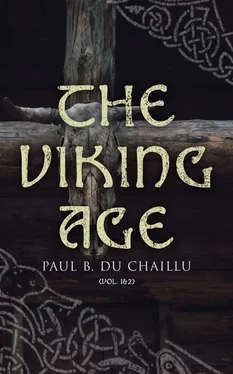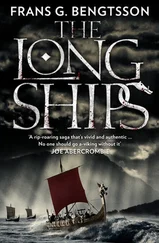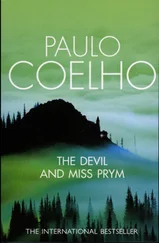Men, particularly the slain after a battle, were sometimes given to Odin for victory, the largest number ever given being those who fell at the famous battle of Bravalla. It seems to have been customary to redden the altars with the blood of the fallen chiefs. 263
Prisoners of war, no matter what their rank, were called thralls, and were sacrificed; sometimes they were slaughtered like animals, their blood put into bowls, and their bodies thrown into bogs or a spring outside the door of the temple called blót-kelda (sacrificing spring), or their backs broken on sharp stones; sometimes they were thrown from high cliffs. 264
“Thorgrim Godi was a great sacrificer; he had a large temple raised in his grass-plot, 265one hundred feet in length and sixty in breadth, and every man was to pay temple-tax to it. Thor was most worshipped there; the inmost part of it was made round as if it were a dome; it was all covered with hangings, and had windows; Thor stood in the middle, and other gods on both sides. There was an altar in front made with great skill and covered above with iron; on it there was to be a fire which should never die out, which they called holy fire. On the altar was to lie a large ring of silver, which the temple priest was to wear on his arm at all meetings. Upon it all oaths were to be taken in cases of circumstantial evidence. On the altar was to stand a large bowl of copper, in which was to be put the blood which came from the cattle or men given to Thor; these they called hlaut (sacrifice-blood), and hlaut-bolli (sacrifice-bowl). The hlaut was to be sprinkled on men and cattle, and the cattle were to be used for the people (to eat) when the sacrificing feasts were held. The men whom they sacrificed were to be thrown down into the spring which was outside near the doors, which they called blót-kelda . The cross-beams which had been in the temple were in the hall at Hof, when Olaf Jónsson had it built; he had them all split asunder, and yet they were still very thick” (Kjalnesinga, c. 2).
“On Thorsness, where Thórólf Mostrarskegg landed, there was a very holy place (helgi-stad); and there still stands Thor’s stone, on which they broke 266those men whom they sacrificed, and near by is that dom-ring where they were sentenced to be sacrificed” (Landnama ii., c. 12).
This passage shows that the dom-ring where men were sacrificed was different from the dom-ring where the people met to judge; the former seems to have been always made with stones, while the latter, as we have seen from Egil’s Saga, were made with hazel poles. It is probable that many of the dom-rings which are now seen were used as sacrificing places.
Not far from the large ship-form grave of Blomsholm, in a silent pine forest, stands a magnificent Dom-ring (see next page 370), a witness of the great past. What unwritten records are stamped upon its stones! what unrevealed histories lie for ever buried from our sight! how much they would tell if they could speak! The ring is about 100 feet in diameter, and is composed of ten standing stones. Near by is the eleventh. In the centre is a huge boulder, overlooking the rest; its uncovered part stands about 5 feet above the ground; it is 9 feet long by 7 feet wide.
“When Thórd gellir established the fjordungathing (quarter Things) he let the Thing of the Vestfirdingar be there (on Thorsness); thither men from all the Vestfjords were to come. There may still be seen the dom-ring within which men were doomed to be sacrificed. Within the ring stands Thor’s stone, on which those were broken who were used for sacrifice, and the blood-stains can still be seen on the stone” (Eyrbyggja, c. 10).
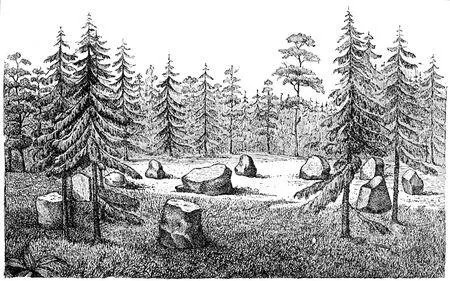
Fig. 778.—Dom-ring, or sacrificing ring, Blomsholm, Bohuslän.
Many dom-rings 267are seen in the country without the sacrificing stone in the centre; these may have been used as enclosures for duelling, while others similar to the above engraving may have been horg or sacred altars.
Sacrificing mounds, and apparently mounds in which offerings were deposited, are mentioned, but unfortunately we have no description of them.
“King Olaf 268had there (Karlsá) broken the sacrificial mound of the heathens; it was so called because usually, when they had great sacrifices for a good season, or for peace, all were to go to this mound, and there sacrifice prescribed animals; they carried thither much property, and put it into the mound before they went away. King Olaf got very much property there” (Fornmanna Sögur v. 164.)
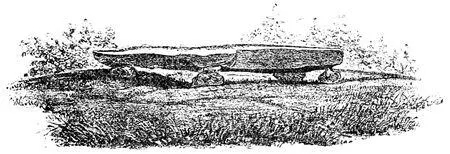
Fig. 779.—Probably a sacrificing slab, on a rocky ridge at Viala, Vingåkers parish, Södermanland, overlooking Lake Kolsnaren; 7 feet 10 inches in length, 5 feet 10 inches in width, and 10 inches thick.
“A mound composed of earth and pure pfennings; for thither must be carried a handful of silver and a handful of mould for every one who dies, and also for every one who is born. Odd said: ‘Then kinsman Gudmund you shall go ashore with your men to the mound this night, according to this man’s direction; and I will take care of the ships with my men.’ They did this, and went to the mound, where they collected as much money as they could carry, and with their burden returned to the ships. Odd was well satisfied with the results, and delivered the man into their keeping. ‘Keep good watch over him,’ he said, ‘for his eyes are all the time turned towards the shore, so that he could not have found it as disagreeable there as he says.’ Odd with his men then went ashore, and up to the mound. Gudmund and Sigurd, meanwhile watching the ships, put the man between them, and began to sift away the mould from the silver; but when they least expected it he jumped up and overboard, and swam towards the land. Gudmund snatched a harpoon and shot after him; it pierced the calf of his leg, but he reached the shore and disappeared in the forest. When Odd with his companions arrived at the mound, they each decided to take burdens according to their strength, but on no account heavier than could be easily carried” 269(Orvar Odd’s Saga, c. 9 & 10).
Among the human sacrifices were those called blódörn (blood eagle), so called on account of the skin or flesh being cut down the whole back to the ribs, from both sides of the spine, in the shape of an eagle, and of the lungs being drawn through the wound. This special mode of sacrifice seems to have been practised on the slayer of a man’s father. 270
“After King Harald Fairhair’s sons had grown up they became very unruly, and fought within the country. The sons of Snœfrid, Halfdan Háleg (high leg) and Gudröd Ljómi, slew Rögnvalld Mœra Jarl. This made Harald very angry, and Halfdan fled westward over the sea, but Gudröd got reconciled to his father. Halfdan went to the Orkneys, and Einar Jarl fled from the isles to Scotland, while Halfdan made himself king of the Orkneys. Einar Jarl returned the same year, and when they met a great battle took place, in which Einar was victorious, and Halfdan jumped overboard. The following morning they found Halfdan on Rinar’s hill. The Jarl had a blood eagle (blodörn) cut on his back with a sword, and gave him to Odin for victory. After that he had a mound thrown up over Halfdan. When the news of this reached Norway his brothers were very angry, and threatened to go to the islands and avenge him; but this Harald prevented. Somewhat later Harald went westward across the sea to the isles; Einar went away from the islands, and over to Caithness (Katanes). After this men intervened and they became reconciled. Harald laid a tribute on the islands, and ordered them to pay sixty marks of gold. Einar Jarl offered to pay the tribute, and in return possess all the odals (allodial rights). This the bœndr agreed to, for the rich thought they would buy them back, and the poor had not property enough to pay the tribute. Einar paid it, and for long after the jarls possessed all the odals, until Sigurd Jarl gave them up to the men of the Orkneys. Einar Jarl ruled long over the Orkneys, and died on a sick bed” (Flateyjarbók, p. 224, vol. i.).
Читать дальше
